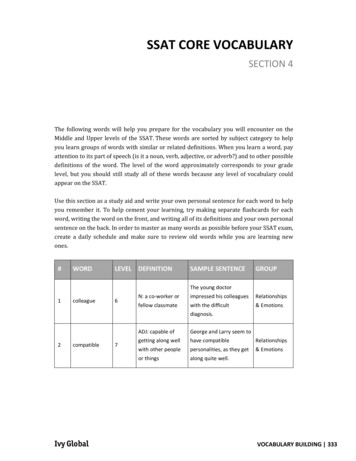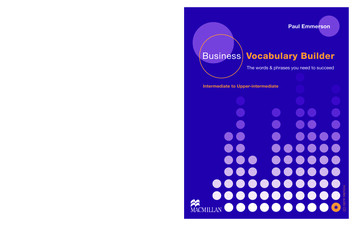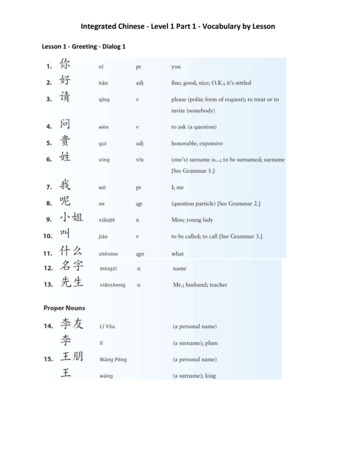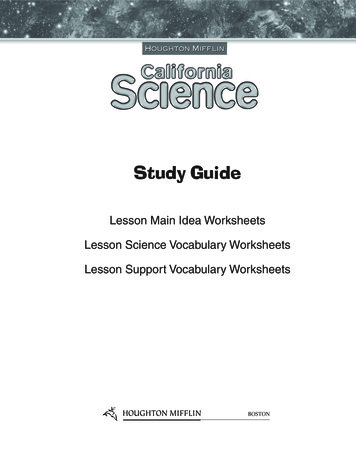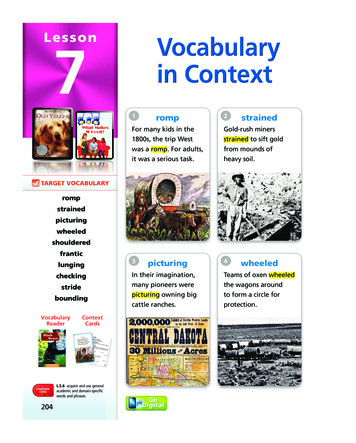
Transcription
LessonVocabularyin Context71romp2strainedFor many kids in the1800s, the trip Westwas a romp. For adults,it was a serious task.Gold-rush minersstrained to sift goldfrom mounds ofheavy soil.34TARGET anticlungingIn their imagination,many pioneers werepicturing owning bigcattle nceStrategy:VisualizeBlackBears5.2.2 Build VocabularypicturingwheeledTeams of oxen wheeledthe wagons aroundto form a circle forprotection.ContextCards1romprompin theFor many kidsWest1800s, the trip. For adults,was a romps task.it was a seriouWhatDoesIt MeaA romn?p is energetic playThinking.AboutIt.Whatactivthe park ities mightbe invo?lved ina romTalk Itp inOver.Whichthingsbeloin a romp? Com w would proba partpare yourablyner.answers be involvedwith those ofHOUGHTON MIFFLINfrowningOnline 0-547-02628-2ISBN-10:0-547-02628-5studyingby Sarah Jane Brian Houghton1032573HOUGHTON MIFFLIN5 026285 VR2 2BL BEARS CVR.indd 15 246789RTXEAN L07.indd 125MifflinPMHarcourt 1/15/09 3:51:37PublishingCompany.All rightsreserved.5 246789RTXEAN L07.indd12/28/07 1:48:09 PMtumbling611261/15/09L.5.6 acquire and use generalacademic and domain-specificwords and phrases2045 RFLESE861555 U2VC07.indd 2043:51:49PMGoDigital5/4/2012 6:51:42 PM
Lesson 7Study each Context Card.Use a thesaurus to find a synonym for eachVocabulary word.5shouldered6franticPioneers may haveshouldered newbornanimals to carry them,just like this farmer.Frightened by thestorm, this frenziedherd of buffalo begana frantic stampede.89checkingStopping, or checking,the wandering waysof sheep is the job ofthese farm dogs.stridePioneers who walkedhad to match theirstride, or step, to thepace of the wagons.7lungingThese goats, like theones on farms, enjoylunging, or dashing, ateach other.10boundingThis man is cheeredby his happy dogbounding forward togreet him.2055 RFLESE861555 U2VC07.indd 2055/4/2012 6:51:57 PM
Read andComprehendGoDigitalTARGET SKILLUnderstanding Characters As you read “Old Yeller,”note the ways in which the narrator, Travis, and his brother,Arliss, are similar and different. Look for text evidenceto help you examine their actions and their traits. Bycomparing the two characters, you will learn more aboutwho they are and why they behave as they do. Recordyour details in a graphic organizer like the one shown here.TravisArlissTARGET STRATEGYVisualize When you visualize, you use text details toform pictures in your mind. As you read “Old Yeller,” usesights, sounds, and other details in the text to picture eachscene. By visualizing what Travis experiences, you canbetter understand his actions.RL.5.3 compare and contrast characters, settings, or events, drawing on details2065 RFLESE861555 U2RC07.indd 2065/4/2012 6:47:46 PM
PREVIEW THE TOPICResponsibilityYou may have heard someone described as having“a sense of responsibility.” This sense has nothing todo with hearing, smelling, tasting, touching, or seeing.Rather, it means that the person is dependable. He orshe does what needs to be done, even when tasks arehard or unpleasant.Travis, the narrator of “Old Yeller,” has a strong senseof responsibility. While his father is away, he takes onall of the chores needed to keep the family farm going.As you read the story, you will see that he also feelsresponsible for keeping his brother safe.2075 RFLESE861555 U2RC07.indd 2075/4/2012 6:47:57 PM
Lesson 7ANCHORTEXTMEET THE AUTHORFred GipsonFred Gipson was born in 1908in Texas’s Hill Country, whichbecame the setting for manyof his stories. He believed thatOld Yeller was his best book. It won the 1957Newbery Honor and was made into a movie.Although Gipson died in 1973, his books remainpopular classics.MEET THE ILLUSTRATORTARGET SKILLUnderstanding CharactersUse text details to compareTravis’s actions and traits tothose of his brother.Marc ElliotLike many kids, Marc Elliot lovedto draw dinosaurs, only Marcwas determined to draw themlife-sized on taped-together cardboard in hisliving room. These days, Marc tries to keep hisillustrations to a size that will fit between twobook covers. He lives on a farm with sheep, twodonkeys, and two crazy long-haired cats.GENREHistorical fiction is a storyset in the past. It containscharacters, places, and eventsthat actually existed orhappened, or that could haveexisted or happened. As youread, look for:realistic characterssome made-up eventsdetails that show the storytook place in the pastRL.5.3 compare and contrast characters,settings, or events, drawing on details;RL.5.10 read and comprehend literature208GoDigital5 RFLESE861555 U2ATO07.indd 2085/23/2012 9:10:17 AM
by Fred Gipsonselection illustrated by Marc ElliotESSENTIAL QUESTIONHow can dangeroussituations bring peoplecloser together?2095 RFLESE861555 U2ATO07.indd 2095/4/2012 6:37:12 PM
It is the late 1860s. Travis lives with his family onthe Texas frontier. When Papa leaves home to drivetheir cattle to market in Kansas, Travis must takeover Papa’s responsibilities. All goes well until astray yellow dog shows up. Travis’s younger brother,Little Arliss, loves the dog, but Travis thinks themangy animal is nothing but a “meat-stealingrascal.” Then one day something happens thatchanges Travis’s feelings about the dog forever.Swinging that chopping axe was sure hard work.The sweat poured off me. My back muscles ached.The axe got so heavy I could hardly swing it. Mybreath got harder and harder to breathe.An hour before sundown, I was worn down toa nub. It seemed like I couldn’t hit another lick.Papa could have lasted till past sundown, but I didn’tsee how I could. I shouldered my axe and startedtoward the cabin, trying to think up some excuse totell Mama to keep her from knowing I was playedclear out.That’s when I heard Little Arliss scream.2105 RFLESE861555 U2AT07.indd 2105/8/2012 4:17:54 PM
Well, Little Arliss was a screamer by nature. He’d scream whenhe was happy and scream when he was mad and a lot of times he’dscream just to hear himself make a noise. Generally, we paid no moremind to his screaming than we did to the gobble of a wild turkey.But this time was different. The second I heard his screaming,I felt my heart flop clear over. This time I knew Little Arliss was inreal trouble.I tore out up the trail leading toward the cabin. A minute before,I’d been so tired out with my rail splitting that I couldn’t have strucka trot. But now I raced through the tall trees in that creek bottom,covering ground like a scared wolf.Little Arliss’s second scream, when it came, was louder andshriller and more frantic-sounding than the first. Mixed with it was awhimpering crying sound that I knew didn’t come from him. It was asound I’d heard before and seemed like I ought to know what it was,but right then I couldn’t place it.Then, from way off to one side came a sound that I would haverecognized anywhere. It was the coughing roar of a charging bear.I’d just heard it once in my life. That was the time Mama had shotand wounded a hog-killing bear and Papa had had to finish it off witha knife to keep it from getting her.ANALYZE THE TEXTDialect Why does the authorinclude less-formal language likeI felt my heart flop clear over, Itore out up the trail, and finishit off? What does the character’sdialect add to the story?2115 RFLESE861555 U2AT07.indd 2115/8/2012 4:18:02 PM
My heart went to pushing up into my throat, nearly chokingoff my wind. I strained for every lick of speed I could get out ofmy running legs. I didn’t know what sort of fix Little Arliss hadgot himself into, but I knew that it had to do with a mad bear,which was enough.The way the late sun slanted through the trees had the trailall cross-banded with streaks of bright light and dark shade. I ranthrough these bright and dark patches so fast that the changinglight nearly blinded me. Then suddenly, I raced out into theopen where I could see ahead. And what I saw sent a chill clearthrough to the marrow of my bones.There was Little Arliss, down in that spring hole again. Hewas lying half in and half out of the water, holding on to the hindleg of a little black bear cub no bigger than a small coon. Thebear cub was out on the bank, whimpering and crying and clawingthe rocks with all three of his other feet, trying to pull away. ButLittle Arliss was holding on for all he was worth, scared now andscreaming his head off. Too scared to let go.How the bear cub ever came to prowl close enough for LittleArliss to grab him, I don’t know. And why he didn’t turn on himand bite loose, I couldn’t figure out, either. Unless he was likeLittle Arliss, too scared to think.But all of that didn’t matter now. What mattered was thebear cub’s mama. She’d heard the cries of her baby and wascoming to save him. She was coming so fast that she had thebrush popping and breaking as she crashed through and over it. Icould see her black heavy figure piling off down the slant on thefar side of Birdsong Creek. She was roaring mad and ready to kill.2125 RFLESE861555 U2AT07.indd 2125/8/2012 4:18:10 PM
And worst of all, I could see that I’d never get there in time!Mama couldn’t either. She’d heard Arliss, too, and here she camefrom the cabin, running down the slant toward the spring, screaming atArliss, telling him to turn the bear cub loose. But Little Arliss wouldn’tdo it. All he’d do was hang with that hind leg and let out one shrillshriek after another as fast as he could suck in a breath.Now the she bear was charging across the shallows in the creek.She was knocking sheets of water high in the bright sun, charging withher fur up and her long teeth bared, filling the canyon with that awfulcoughing roar. And no matter how fast Mama ran or how fast I ran, theshe bear was going to get there first!2135 RFLESE861555 U2AT07.indd 2135/8/2012 4:18:16 PM
2145 RFLESE861555 U2AT07.indd 2145/8/2012 4:18:24 PM
I think I nearly went blind then, picturing what was going tohappen to Little Arliss. I know that I opened my mouth to scream andnot any sound came out.Then, just as the bear went lunging up the creek bank towardLittle Arliss and her cub, a flash of yellow came streaking out ofthe brush.It was that big yeller dog. He was roaring like a mad bull. Hewasn’t one-third as big and heavy as the she bear, but when he piledinto her from one side, he rolled her clear off her feet. They wentdown in a wild, roaring tangle of twisting bodies and scrambling feetand slashing fangs.As I raced past them, I saw the bear lunge up to stand on her hindfeet like a man while she clawed at the body of the yeller dog hangingto her throat. I didn’t wait to see more. Without ever checking mystride, I ran in and jerked Little Arliss loose from the cub. I grabbedhim by the wrist and yanked him up out of that water and slung himtoward Mama like he was a half-empty sack of corn. I screamed atMama. “Grab him, Mama! Grab him and run!” Then I swung mychopping axe high and wheeled, aiming to cave in the she bear’s headwith the first lick.ANALYZE THE TEXTAuthor’s Word Choice The author uses wordssuch as lunging, roaring, scrambling, andslashing to provide sensory details. Howdo these words help you picture what ishappening in the story?2155 RFLESE861555 U2AT07.indd 2155/8/2012 4:18:34 PM
But I never did strike. I didn’t need to. OldYeller hadn’t let the bear get close enough. Hecouldn’t handle her; she was too big and strongfor that. She’d stand there on her hind feet,hunched over, and take a roaring swing at himwith one of those big front claws. She’d slaphim head over heels. She’d knock him so farthat it didn’t look like he could possibly get backthere before she charged again, but he alwaysdid. He’d hit the ground rolling, yelling hishead off with the pain of the blow; but somehowhe’d always roll to his feet. And here he’d comeagain, ready to tie into her for another round.I stood there with my axe raised, watchingthem for a long moment. Then from up towardthe house, I heard Mama calling: “Come awayfrom there, Travis. Hurry, son! Run!”That spooked me. Up till then, I’d beenready to tie into that bear myself. Now,suddenly, I was scared out of my wits again. I rantoward the cabin.2165 RFLESE861555 U2AT07.indd 2165/8/2012 4:18:42 PM
But like it was, Old Yeller nearly beat me there. I didn’t see it, ofcourse; but Mama said that the minute Old Yeller saw we were all in theclear and out of danger, he threw the fight to that she bear and lit outfor the house. The bear chased him for a little piece, but at the rate OldYeller was leaving her behind, Mama said it looked like the bear wasbacking up.But if the big yeller dog was scared or hurt in any way when hecame dashing into the house, he didn’t show it. He sure didn’t showit like we all did. Little Arliss had hushed his screaming, but he wastrembling all over and clinging to Mama like he’d never let her go. AndMama was sitting in the middle of the floor, holding him up close andcrying like she’d never stop. And me, I was close to crying, myself.Old Yeller, though, all he did was come bounding in to jump on usand lick us in the face and bark so loud that there, inside the cabin, thenoise nearly made us deaf.The way he acted, you might have thoughtthat bear fight hadn’t been anything more thana rowdy romp that we’d all taken part in forthe fun of it.ANALYZE THE TEXTUnderstanding Characters How doesTravis respond to the bear attackingArliss? What does his response say abouthis feelings toward his brother?2175 RFLESE861555 U2AT07.indd 2175/8/2012 4:18:50 PM
2185 RFLESE861555 U2AT07.indd 2185/8/2012 4:19:00 PM
Till Little Arliss got us mixed up in that bear fight, I guess I’d beenlooking on him about like most boys look on their little brothers. Iliked him, all right, but I didn’t have a lot of use for him. What withhis always playing in our drinking water and getting in the way of mychopping axe and howling his head off and chunking me with rockswhen he got mad, it didn’t seem to me like he was hardly worth thebother of putting up with.But that day when I saw him in the spring, so helpless against theangry she bear, I learned different. I knew then that I loved him as muchas I did Mama and Papa, maybe in some ways even a little bit more.So it was only natural for me to come to love the dog that saved him.After that, I couldn’t do enough for Old Yeller.2195 RFLESE861555 U2AT07.indd 2195/8/2012 4:19:09 PM
COMPREHENSIONDig DeeperHow to Analyze the TextUse these pages to learn about Understanding Characters,Author’s Word Choice, and Dialect. Then read “Old Yeller” againto apply what you learned.Understanding CharactersThe story of “Old Yeller” is told through the eyes of its maincharacter, Travis. Readers learn not only what Travis does and says,but also what he thinks and feels.In the selection, Travis and his little brother, Arliss, are caught inthe same conflict. Readers learn about Arliss through his actionsand what Travis tells about him. Comparing the two charactersreveals more about each one’s personality and their relationship.Look closely for details that tell you about Travis and Arliss.Think about their different reactions to situations. What do youlearn about Travis from his response to events? What do you learnabout Arliss?TravisArlissRL.5.3 compare and contrast characters, settings, or events, drawing on details; RL.5.10 read and comprehend literature; RF.5.4a read on-leveltext with purpose and understanding; L.5.3b compare and contrast varieties of English in stories, dramas, or poems2205 RFLESE861555 U2DD07.indd 220GoDigital5/4/2012 6:38:34 PM
Author’s Word ChoiceSensory language is languagethat helps readers see, hear, andexperience what happens in a story.Recall the scene from “Old Yeller”in which Travis first realizes that acharging bear is after Little Arliss.The author uses words and phrasessuch as “popping,” “breaking,” and“awful coughing roar” to build theintensity of the moment and tomake readers feel as if they are inthe scene with Travis.DialectDialect, a variety of Englishassociated with a certain place orgroup of people, adds realism tohistorical fiction such as “OldYeller.” On page 210, Travis usesexpressions such as “worn down toa nub” and “I couldn’t hit anotherlick” to describe how tired he isafter chopping wood. Theseexpressions fit his character and thestory’s setting. They also helpestablish Travis's voice as he beginsto narrate the story.2215 RFLESE861555 U2DD07.indd 2215/4/2012 6:38:43 PM
Your TurnRETURN TO THE ESSENTIAL QUESTIONReview the selectionto prepare to discussthis question: How candangerous situations bringpeople closer together? Taketurns sharing your insights in asmall group. Elaborate on eachother’s comments.TurnandTalkClassroomConversationContinue your discussion of “OldYeller” by using text evidence toexplain your answers to thesequestions:1How does the setting affect whathappens in the story?2Is Travis a good choice for thenarrator of this story? Explain.3What conclusions about life onthe frontier can you draw fromthe story?DISCUSS CHARACTER GROWTHPartner Talk How do Travis’s feelingstoward his brother change during the story?With a partner, discuss how the incident withthe bear affects Travis. Then evaluatewhether his change in perspective isbelievable, based on your ideas about howreal people react and feel in such situations.Share your observations with the class.2225 RFLESE861555 U2YT07.indd 2225/4/2012 6:54:05 PM
WRITE ABOUT READINGResponse To determine the theme, ormessage, of a short story, think about howthe main character responds to conflict. Forexample, how does Travis react when hisbrother is in danger? Write a paragraphexplaining how Travis’s actions reveal ageneral message about life or people.Support your ideas with quotations andother text evidence.Writing TipBe sure to use quotation marks aroundphrases or sentences that you take directlyfrom the text. Include only those detailsthat support your main idea.GoDigitalRL.5.1 quote accurately when explaining what the text says explicitly and when drawing inferences; RL.5.2 determine theme fromdetails/summarize; W.5.9a apply grade 5 Reading standards to literature; W.5.10 write routinely over extended time frames andshorter time frames; SL.5.1a come to discussions prepared/explicitly draw on preparation and other information about the topic;SL.5.1c pose and respond to questions, make comments that contribute to the discussion, and elaborate on others' remarks2235 RFLESE861555 U2YT07.indd 2235/4/2012 6:54:24 PM
Lesson 7PERSUASIVE TEXTby Cynthia BenjaminGENREPersuasive text, such asthis readers’ theater, seeks toconvince the reader to think oract in a certain way.Cast of CharactersTelevision HostAnimal Expert Kay NyneHistorian Lester YearHost: Welcome to What Makes It Good?, theTEXT FOCUSPersuasive techniques,such as the authoritative tonesused by the experts beinginterviewed in this selection, areused to sway readers’ thinkingor call readers to action.movie review show that asks the experts if amovie is accurate enough to be good. Today weare reviewing the film version of Old Yeller, andwe have two experts with us. One is historianLester Year, who writes about life on thenineteenth-century Texas frontier. The other isanimal expert Kay Nyne.First up is our animal expert. What makesOld Yeller good?RI.5.10 read and comprehend informationaltext2245 RFLESE861555 U2PS07.indd 224GoDigital5/4/2012 6:46:02 PM
Kay Nyne: The accurate portrayal of animals makesOld Yeller good. If the bear squeaked like a mouse, orif Old Yeller ran away from his owners, then you wouldnot believe the story.For instance, I loved the scene with Old Yellerbounding into the cabin to lick Arliss in the face! Weknow that dogs often lick their masters on the face orhand, so it makes sense that Old Yeller would lick theyoung boy after saving him.I also thought the way Old Yeller went lunging atthe attacking bear in a frantic attempt to save Arliss wasvery realistic. Dogs are loyal animals. In fact, dogs andpeople have lived together for more than ten thousandyears! Mother bears are fiercely protective of theircubs. I have no problem picturing a bear attacking if shethought her cub were in danger. It is details like thesethat make the movie believable and exciting.2255 RFLESE861555 U2PS07.indd 2255/4/2012 6:46:10 PM
Lester Year: Now wait a minute! That fightbetween Old Yeller and the bear was exciting,I admit. But what makes the movietruly great is its historical accuracy. IfTravis had broken his stride, wheeledaround and seen the bear, thendialed 9-1-1 on a cell phone, youwould not believe it.But he does not carry a cell phone.He has shouldered an ax. I hope younoticed the ax. It was an excellentexample of an important 1860s tool. Livingon the frontier was no romp on the playground,and pioneers depended on their tools for survival.Ah, now that scene of Old Yeller licking Arlissafter checking the bear’s attack may be veryaccurate as far as dog behavior is concerned.But more important, the cabin looks veryrealistic, down to the notches holding the logsin place. If the cabin had wallpaper, you wouldhave strained to believe the scene. That is whyhistorical accuracy is more important.Host: We are almost out of time. Let’ssummarize. Old Yeller is a good moviebecause it is . . .Kay Nyne: Scientifically accurate.Lester Year: Historically accurate.Host: Well, they may never agree.Audience, I guess you have todecide for yourself what makesit good!2265 RFLESE861555 U2PS07.indd 2265/4/2012 6:46:20 PM
Compare TextsTEXT TO TEXTAnalyze Viewpoint In “What Makes It Good?” Lester Year makesa clear argument about “Old Yeller” and provides evidence tosupport it. Identify Lester Year’s viewpoint. Then make a list of allthe ideas and text evidence from “Old Yeller” that supports hisviewpoint. Include those that he mentions from the film, as well asthose you find in the text. Use your list to write a sentence or twoexplaining how the ideas and text evidence work together toOvermatterform a solid argument.TEXT TO SELFWrite About an Animal Think about an experience youhave had with an animal, or an experience you would like tohave. Write a narrative paragraph about the experience.Include details that convey your thoughts and feelings.Draw a picture to accompany your paragraph, and provide acaption for your drawing.TEXT TO WORLDCompare Dialects The authors of “Old Yeller” and “Off and Running”(Lesson 3) use types of dialect to make their story characters realistic. With apartner, create a T-Map listing examples of dialect from each story. Compareand contrast the unique words and phrases found in each dialect. Discusswhether you think the dialect helps define the characters who use it, and why.GoDigitalRI.5.8 explain how an author uses reasons and evidence to support points; W.5.4 produce writing in which development and organization areappropriate to task, purpose, and audience; W.5.10 write routinely over extended time frames and shorter time frames; L.5.3b compare andcontrast varieties of English in stories, dramas, or poems2275 RFLESE861555 U2PS07.indd 2275/4/2012 6:46:33 PM
L.5.3a expand, combine, and reduce sentencesGrammarGoDigitalWhat Is a Direct Object? A direct object is the word in thepredicate that receives the action of the verb. It can be a noun or apronoun, a word that takes the place of a noun. A compounddirect object is made up of two or more words that receive theaction of the same verb.Verbs and Objectsaction verb direct objectThe boy swung his axe.action verbcompound direct objectHe chopped big logs and small branches.What Receives the ActionAxe receives the action of theverb swung.Logs and branches receive theaction of the verb chopped.An indirect object usually tells to whom or to what the actionof the verb is done. The indirect object comes between the verband the direct object.action verb indirect object direct objectThe boy gave his brother a treat.Brother tells to whom thetreat was given.Try This!The action verb in each sentence is printed inbold type. Find the direct object. Then find theindirect object, if one is used.1Mom wrote Dad a letter.2She described the big fight.3Our dog protected my brother and me.4We gave our dog great praise.2285 RFLESE861555 U2G07.indd 2285/4/2012 6:40:19 PM
You can improve the flow of your writing by combining sentencesin which the direct objects receive the action of the same verb. First,identify the subject, verb, and direct object of each sentence. Thencombine the sentences, using and or or to join the direct objects.Separate SentencesThe brave dog fought a bear.The brave dog fought amountain lion.Combined Sentence with Compound Direct ObjectThe brave dog fought a bear and a mountain lion.Connect Grammar to WritingAs you revise your compare-contrast essay this week, see whereyou can create compound direct objects to combine sentences.Combining sentences will help make your writing smoother.2295 RFLESE861555 U2G07.indd 2295/4/2012 6:40:21 PM
W.5.2a introduce a topic, provide an observation and focus, group related information/include formatting, illustrations, and multimedia;W.5.2b develop the topic with facts, definitions, details, quotations, or other information and examples; W.5.2e provide a concludingstatement or section; W.5.5 develop and strengthen writing by planning, revising, editing, rewriting, or trying a new approachInformative WritingWord ChoiceThe author of “Old Yeller“ uses vividdescriptions and action to tell a great story. You can analyzedescriptions and events in a story to compare and contrast parts of itin your writing.Stefania drafted a compare-contrast essay to explain howOld Yeller and the bear are alike and different. Later, she addedquotations and precise details from the text to support her ideas.Use the Writing Traits Checklist below as you revise your writing.Writing TraitsChecklistIdeasDid I develop my topicwith quotations andexamples?OrganizationDid I explain mycomparisons andprovide a conclusion?Sentence FluencyDid I vary the structureof my sentences?Word ChoiceDid I use precisewords and detailsfrom the text?VoiceIs my writing clear andinformative?ConventionsDid I use correct spellingand grammar?GoDigitalRevised DraftThe most exciting scene in “Old Yeller“is when Old Yeller fights the mother bear inorder to protect Arliss. The author describesboth animals as ready to fight. The bear“roaring mad and ready to kill.”is protecting her cub and Old Yeller isand “roaring like a mad bull.”protecting Little Arliss . When Old Yeller seesthat Little Arliss is in danger, he takes action.runs at the bear and knocks her off her feet2305 RFLESE861555 U2W07.indd 2305/4/2012 6:50:55 PM
Final CopyOld Yeller and the Bearby Stefania AlmeidaThe most exciting scene in “Old Yeller“ is when Old Yellerfights the mother bear in order to protect Arliss. The authordescribes both animals as ready to fight. The bear is protectingher cub and “roaring mad and ready to kill.” Old Yeller isprotecting Little Arliss and “roaring like a mad bull.” When OldYeller sees that Little Arliss is in danger, he runs at the bear andknocks her off her feet. The bear stands her ground, as well.She keeps fighting until the end when Old Yeller outruns her andgoes back to the family’s house.The main difference between the two animals is their size. Thebear is much bigger and stronger than Old Yeller. This sizedifference does not scare Old Yeller, though. He acts on hisprotective instincts and takes on an animal three times his size.The bear is brave, as well. She believes her cub is in danger andis willing to do anything to protect it. Once Old Yeller knows thatArliss and the rest of the family are out of danger, he stopsfighting. Though the bear chases him for a bit, she eventuallygives up, too, and probably returns home with her cub. Bothanimals do what is necessary to protect those they care about.Reading as a WriterWhich details made Old Yeller’sand the bear’s similarities anddifferences clear? Where in yourwriting can you make similaritiesand differences more clear?In my final paper, I used quotations andprecise details from the textto support my ideas.2315 RFLESE861555 U2W07.indd 2315/4/2012 6:51:06 PM
5_246789RTXEAN_L07.ind d 126 1/15/09 3:51:49 PM For many kids in the est was a romp. For adults, it was a serious task. 1 5_246789RTXEAN_L07.indd 125 1/15/09 3:51:37 PM HOUGHTON MIFFLIN 1032573 ISBN-13:978--547-02628-2 ISBN-10:0-547-02628-5 HOUGHTON MIFFLIN Online Books Black Bears by Sarah Jane Brian Science Strategy: Visualize 5.2.2 Build .

